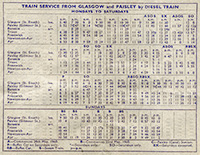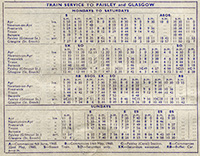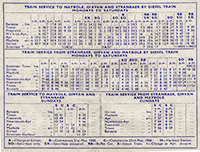Class 126 Swindon Inter-City 3-car DMUs
Operations
They entered service in August 1959 from Ayr depot and were mostly used on Glasgow to Ayr, Girvan and Stranraer workings.
Originally it wasn't planned to use the vehicles on the Stranraer service, this was a decision made just before the vehicles were delivered. Once this decision was made the two buffet cars were ordered but couldn't be fitted into the build programme at Swindon till later. The Stranraer services were known as the boat trains as they connected with the ferry to Larne (Northern Ireland) at Stranraer Harbour station. These were normally six-car formations. The buffet cars were not a success on the service and were soon transferred to Edinburgh and Glasgow services.

The image shows the Glenwhilly signalman heading back to the signalbox as the 10.42am Glasgow Central - Stranraer Harbour continues through the closed station on the 10th August 1973. Michael Mensing.
Although the intention of the two cab types was to allow access throughout a six-car formation, connecting DMS to DMS, in practice it seemed that sets were rarely in the correct sequence for this to work.
As can be expected, excursions saw then visit unusual places such as Perth / Dundee, and the Callander / West Highland Line on a Six-Lochs Land Cruise, and also maintenance needs also saw some visit Inverurie Works (although Glasgow Works did the majority of the heavy work).
Initially the Ayr / Girvan / Stranraer services ran out of Glasgow St.Enoch station, when it closed the Ayrshire services were transferred to Central station. The sets would on occasion be found on other services such as from Glasgow to Ardrossaon, East Kilbride, Largs and later Carlisle. More unusual routes they were noted on included to Wemyss Bay / Gourock and Adrossan - Kilmarnock, Ayr - Dalmellington, Heads of Ayr, Barrhead - Kilmarnock, Dalry - Kilmarnock and Kilmacolm.
The class was involved in some notable accidents involving collisions with EMUs outside Glasgow Central in 1970, at Shields Junction in 1973 and at Paisley in 1979.
Mass withdrawals happened in the early 1980s, all the class being withdrawn by the end of 1982. However two sets were re-instated and lasted until January 1983. Although used on various other routes out of Glasgow in their final years, these 126s remained closely identified with the Ayr line until displacement by a mixture of loco-hauled trains and other DMUs. After withdrawal two sets moved to undercover storage in Dunfermline Townhill depot so preservationists could select the three vehicles they wanted.
Deliveries

Deliveries began in April 1959 and they were not delivered as three-car sets but, in common with other Swindon-built vehicles delivered to date, in small batches of different vehicle types. Many were stored initially at Hurlford, or at Lugton Goods Yard where 59402/3 & 51012/3 were noted on the 16th May. The vehicles may have been stored at these locations until deliveries allowed proper sets to be formed, but also as work on the diesel shed at Ayr had only just begun, and the coach sidings at Kyle Street at the north-west end of Ayr station were being reconfigured as a diesel unit refuelling facility.
The image shows new vehicles stored at Lugton on the 30th May 1959. Note the headcode on the intermediate power car, it has been given an 'A' on each side of the gangway. WAC Smith.
19/5/59 Press release - Diesels will replace steam on the Glasgow / Ayr route this autumn
"The first of the new diesels will be used to train drivers at present on steam locomotives. When a number of drivers have qualified, it might be possible to introduce some diesels this summer on excursions or off-peak services."
Details announced at the time included a new morning diesel train at 8:00am from Ayr, serving Prestwick, Troon and Paisley, reaching Glasgow in 50 mins. A start would be made on the Glasgow - Largs route by using six diesel trains on weekdays and four on Saturdays. It was also announced they would now also be introduced on the Glasgow to Stranraer service, working the “Irishman”, the boat train connecting with the Stranraer - Larne sailings. The Glasgow - Ayr service would consist of 28 trains each way, replacing the previous 20 steam trains. In addition to the extra trains at peak hours, there would be two trains every hour for much of the day. One other Stranraer service would also be taken over.
The announcement mentioned that twelve 6-car sets were to be allocated to these workings, with nine required for the Ayrshire services. Note there were only 66 Ayrshire vehicles built - ten 6-cars plus spares, the balance was made up using some 79xxx cars released from the Western Region.
Intermediates 79083-5/9 and 79470 moved direct from the Western Region to Ayr in October 1959. 79086 moved from Leith to Ayr when 79083-5 arrived. 79089 may have moved to Leith when the last Ayrshire intermediate, 50936, was delivered in November. Buffets 79440/1 moved north to Leith then to Ayr in October for the start of the services. Other 79xxx vehicles to work from Ayr over the years include 79088, 79165/8, 79471/8/9/82.
Despite the common White Circle coupling code and only being built three years apart, for the 79xxx & 5xxxx vehicles to work in multiple together alterations were required to the wiring on the 79xxx fleet.
Sc51011 was noted in Glasgow Central station on the 22nd June, possibly on display.
Ayrshire sets not in Ayrshire
The new vehicles did not sit idle until the Ayshire services were introduced, some were used out of Leith Central depot on the Edinburgh - Glasgow line.
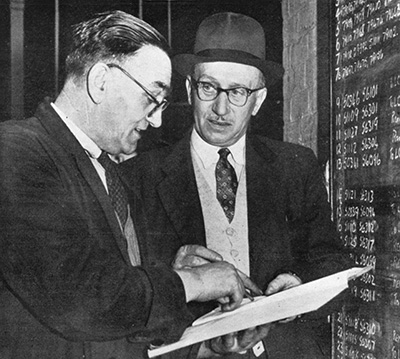

The Scottish Region edition of the June 1959 British Railways staff magazine had a photo feature on the staff of Leith Central depot at work. The shed master Henry Buist was photographed talking to Running Foreman James Fisher in front of what was called the "Tally Board" showing the daily position of the sets. At the top, above the GRC&W and Met-Camm formations are the Inter-City DMUs and set seven is 79100 59392 51011 79102. The extend of their use at Leith is not too clear, but is probably the reason for the E&G type headcode seen on the vehicle at Lugton.
Other sightings include 51008, 59392 and 51009 at Queen Street on Friday 24th July 1959.
Aberdeen
In the late 1950s and early 1960s one of the big events for young trainspotters in the Aberdeen area was the Glasgow Fair Saturdays followed by one or two other busy holiday Saturdays when folks from the west coast travelled by train to Aberdeen. Not only did this bring unusual steam locos to Aberdeen such as Princess Royal Pacifics and Royal Scots but also sightings of the brand new DMUs based in the Glasgow area. This included the Glasgow-Ayr Inter-City sets. Vehicles that have been noted as visiting Aberdeen include Sc51012/13; 51030/31/32/33/35/37/38/39/40/41 59391/95/96/97/98; 59402/04/05.

The image shows a set at Dundee with Sc51012 at the front on 4th July 1959, thought to be heading for Aberdeen. The A stencils show it had been in use at Leith, it is also carrying an E&G type gangway cover, rare on this later batch. George Bett.
An early sighting of vehicles in Ayr station was on Saturday 25th July 1959 when a train of eight vehicles arrived at 2.30pm. This train was split into two sets, one of three cars and one of five cars. They were used for crew training, which commenced the following week. The three-car set was 51040, 59395 and 51039 and the five-car set 51038, 79478, 79165, 59405 and 51037. Various new units were seen over the following weeks.
In advance of the official start date which included a fully revised timetable, some sets were introduced on Monday 31st August working to existing steam timings. From that day, four trains in each direction between Ayr and St Enoch were worked by 6-car sets while “comprehensive dieselisation must wait the delayed winter timetable” (with no date given). The services were the 8.30am, 9.00am, 2.55pm and 7.01pm from Ayr to Glasgow and in the opposite direction at 10.45am, 12.35pm, 6.20pm and 9.55pm.
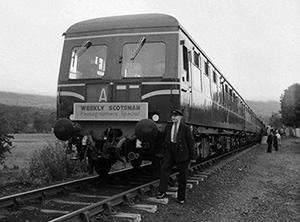
Over the period of the Scottish Industries Exhibition that September, there was an exhibition of rolling stock etc. in Glasgow Central station, including on display an ‘Ayr diesel vehicle’. There were rumours that the delays into traffic were being caused by a 'printing strike'. On Saturday 19th September 51019/20/21 and 51044/5 were seen at Lugton. From September until the end of October the sets gradually took over more of the steam turns.
On 30th September 1959 the 'Weekly Scotsman' publication organised a photographer special through the central Highlands using two of the sets. It is seen in the image at one of the stops. This is one of two prints in their photo archive - image one, image two.
When new, and before they went into regular service, they were employed on a football special from Ayr. There was a buffet in the formation and bottled beer was sold. This resulted in Ayr never using them again for football specials because the fans used the wooden window frames to remove the metal tops from the bottles.
Ayrshire Services Begin
Press Release 6/10/59 - "Glasgow to Ayr dieselisation now to be 2/11/59"
On Monday 2nd November the sets took over as planned, including the trains to Stranraer. The new diesel service brought considerable improvements to the timetable. The fastest train was the 5:10pm (SX) from St. Enoch, calling at Troon and Prestwick instead of running non-stop as in the previous timetable, but retained the overall 50 min journey time. This train, with a buffet car, ran on to Stranraer, and connected with the sailing to Larne. On Saturdays it left at 5:15pm and had an easier schedule with additional stops. The 4:25pm from Stranraer also had a buffet car.
With eleven stops the 1:30pm St. Enoch to Ayr took 74 minutes compared with 83 mins taken by the former steam 2:40pm with ten calls. Girvan also benefited, for example the new 10:30 St Enoch to Girvan took 114 minutes against the 135 minutes of the old 10:45 with much the same stops. Ayr now had 27 services from St Enoch compared with the former 19. Girvan’s frequency was more or less unchanged, while in the case of Stranraer only the 5:10pm and 9:00pm “Irishman” (boat train) gave a through service, in other cases changes at Girvan were necessary. A similar pattern applied for the other direction, the through diesels being the 4:25pm and 9:15pm “Irishman” (the “Paddy”) from Stranraer. A welcome feature was that the Glasgow - Stranraer through services carried a buffet car, for the first time on the line since 1939. There was also a number of diesel workings introduced between Glasgow, Ardrossan and Largs, the timings being little changed on the throughout journey from those of steam, although there was the advantage that the Glasgow - Largs diesels worked into Ardrossan (Town), where reversal was necessary, and this obviated the splitting and uniting of portions at South Beach.

The image is an British Railways publicity print titled 'Glasgow - Ayr - Girvan Inter-City Diesel Train (when new), crossing the River Ayr, 3/11/59'.
The northbound “Irishman” was due into St Enoch at 11:42pm, 9 minutes earlier than the steam timings. It was allowed 47 minutes from Ayr to Glasgow, and the 34 minutes allowed for the 33.6 miles from Ayr to Paisley was thought to be one very fast booking. The 8.57am Girvan to Glasgow was booked for the 27.5 miles from Troon to Paisley in 29 minutes, and the 08:00 from Ayr was given 30 minutes for this stretch. Departures from St Enoch for Ayr and from Ayr to St Enoch were generally on the hour / half-hour, and there were 23 trains making the journey in times between 47 and 65 minutes, as compared with only six previous steam services. However none beat the 1939 schedule for the 5:10pm non-stop timing of 45 minutes.
Between Ayr & Glasgow the 28 diesel services replaced 20 steam, benefiting the traveller by eliminating the approximately two-hour gaps at certain parts of the day – such as between 10:45am and 12:30pm, and 12:35pm and 2:20pm and 2:15pm. The Girvan trains had previously consisted of non-corridor stock for the 62½ mile journey, taking 2½ hours! Except on Saturdays, there were new trains from St Enoch to Ayr at 10:30am, 11:00am, 11:30am, 1:30pm, 2:00pm, 2:30pm and 3:30pm before the continued 4:15pm to Girvan. The 4:15pm was followed by a 5:00pm to Ayr in 55 minutes for the 41½ miles, inclusive of Paisley, Irvine, Troon and Prestwick stops, proceeding the 5:10pm (SX) through buffet working to Stranraer and the 5:15pm to Ayr, extended to Stranraer on Saturdays.
Returning the 7:45am, 8:00am and 8:15am from Ayr took 63, 54 and 65 minutes respectively to St Enoch, the 8:30am stopper was accelerated to 74mins with the same stops, 18 minutes quicker than the previous steam schedule. The first train in from Girvan arrived at 7:28am, but terminated at Ayr as it connected with the business trains, the first through service was the 7:50am ex-Girvan continuing from Ayr as the 8:30am. The other main improvement of the down route was the frequency of the evening trains back to Glasgow, the 5:10pm Glasgow to Stranraer returned complete as the 9:15pm “Irishman” and gave the late passenger from Ayr his first chance of refreshment en-route. The 4:45pm from Stranraer Town, due at Ayr between 6:27pm and 6:30pm, offered an early evening refreshment service, this diesel set returned complete at 9:00pm (8:45pm SO) as the up “Irishman”.
Recollections
Enthusiast Jim Currie noted "Finally on Monday 2nd November 1959 the new diesel timetable and service came into operation. That morning I boarded the 7.45am to Glasgow at Newton-on-Ayr, in the leading coach of course, which was 51045. On the Tuesday it was 51047, then 51031, 51036 and 51030 on the Friday."
Jim, who was a regular commuter between Newton-on-Ayr and Glasgow, also describes the transition from the passengers viewpoint: "It was a grey cold morning in October - the 22nd of that month in 1959 to be precise. Inside the 7.40am commuter train from Ayr to Glasgow it was cold and the windows of the compartment (non-corridor stock in those far off days) were steaming up both inside and out. Inside from the condensation of the cold breath of the passengers and outside from steam escaping from the train heating pipes. The latter seemed surprising as inside it felt there could be no steam at all in the heating system. The train had staggered to an unscheduled halt at Glengarnock. No one in the compartment spoke – all the businessmen were tucked behind their broadsheets. In the yard a Caley Jumbo was resting from shunting activities. Not for long. Before much time had passed 57355 was at the head of the train for a tender first run to Glasgow as pilot to the Class 5 train engine, 45362, which had run out of breath. Surprisingly, good progress was made by the two locomotives and arrival at St Enoch station was only 20 minutes late.
A month later the 5.15pm from St Enoch to Ayr drew quietly into Troon station dead on time. Passengers disembarking got up to vacate the warm compartment (over warm even) and head out into the cold night and go home for tea. Perhaps dinner, since it was Troon we were at. As the motors revved and the train drew out a pin-stripe-suited businessman leapt up out of his seat grabbed his briefcase and coat from the rack and rushed to the door. Too late, as the train was now going too fast, so he settled down again until Prestwick to get the next train back up the line. A scene all too familiar to me as the wonderfully overheated new diesel trains seemed to have a marvellous somnolent effect on many passengers returning home from work on these cold dark nights."
Jim recorded, but without any detail, that there were a large number of breakdowns in the early period, which gradually diminished but still persisted until the end of 1959.
No through access
The Edinburgh - Glasgow sets worked mainly in 6-car formations, but in Ayrshire the sets had to be more flexible, with some services having sets added or removed en-route, or sets added at the termini for peak periods. Ideally the two intermediates should join to give through access, but operations did not always allow this. An early example was on the 13th November 1959, just days after their full introduction, when the 08:15 St. Enoch - Largs had the two sets coupled leading to leading cab. 9-car sets were far from uncommon, and in these early days there was a 9-car in use on Sundays.
Largs
When the Fife dieselisation was underway Ayr received several of the Metro-Cammell 3-car sets intended for Fife at the end of 1959 and used them on self-contained Ayr – Glasgow diagrams. This released a couple of Inter-City sets to work Largs diagrams. The customers on the line had been unhappy at their level of service compared to the Ayr line. These grumblings had started back in 1959/60 and resulted in certain Largs steam trains going over to corridor stock and the loan of a couple of Corkerhill Jubilees to Ardrossan to work them. The Met-Cams were able to go to Fife with the delivery of new Derby 3-cars (later known as Class 107s) which allowed dieselisation of the Ardrossan and Largs service. By the end of 1962 the Glasgow – Largs & Ardrossan services were almost completely dieselised. Normally used were 126s or 107s, but 101s were also know as were Cross-Country’s. But it was 1964 before steam was finally ousted from the Largs workings. At the time there were only through trains to Glasgow in the morning and peak times, with and a shuttle between Largs and Dalry connecting with the Ayr services at other times.
1960
More Services
From January 1960 the rest of the steam services between Girvan and Stranraer were taken over by DMUs meaning the entire passenger service between St. Enoch, Ayr, Girvan and Stranraer was diesel operated. The new timetable on the 1st February 1960 saw the introduction of a new evening train from Ayr to Glasgow, and three more existing services stopped at Irvine, and two at Dalry. The new service departed at 5:55pm daily except Saturdays and stopped at Newton-on-Ayr, Prestwick, Troon, Irvine and Paisley Gilmour Street, arriving in St. Enoch at 7:07pm.
Sunday Work
Engineering possessions on Sundays at Glasgow Central for electrification work in the winter of 1960 meant that St Enoch remained open on Sundays for Ayr, Stranraer, Largs, Gourock and Wemyss Bay trains.

In the image a six-car (2 x 3-car) formation led by DMBS Sc51046 heads north after departing from Ayr past Falkland Junction with a service for Glasgow St Enoch in Spring 1960. Bill Hamilton.
More Recollections
Enthusiast Hugh Dougherty reminisces: "I first came across the spirit of the Swindons as a wee boy of nine, around Easter 1960, when family Dougherty took a day trip to Troon. For there, at the platform in St. Enoch station, in place of the expected compartment steam train, was a green diesel multiple unit, not unlike the Great Northern Railway of Ireland trains that took us from Belfast to Omagh each summer, on the way to holidays in Donegal.
Now, I have to admit to being under the spell of DMUs ever since 1957 when our through coach from Bundoran to Belfast was shunted on to the end of a GNR BUT railcar set at Clones, and subsequent journeys on the GNR included persuading a reluctant parent to arrange a cab visit. But here, right in Glasgow, was a similar machine and soon we were sitting up front, right behind the driver, as we headed out over the Clyde Bridge and through the Gorbals for Cumberland Street to the fascinating sounds that only a Swindon could manufacture.
What struck me, as we headed down the joint line for Paisley, was the rate at which the six-car unit picked up speed and, after Howwood, coming down past Lochside, the speedo showed 70 — much faster than I had ever travelled to date. It was fascinating, too, to watch the rev counter pointer bounce about on its dial as the driver, clad in steam-age overalls, worked the gear change and throttle handles, while the hiss of the vacuum brake could be heard as he braked gently (in good time and far out from station limits), as he shut off power, and checked the six blue lights on the panel beside him which showed that all was well.
These trains felt the part. The seats were high-backed and comfortable, and you could choose between the open coaches or the corridor and compartments of the middle car.
In June 1960 I had the very good fortune to take whooping cough and, in those pre-antibiotic days, the cure was plenty of fresh air. So it was, with my sister at school and my father at work, my mother and I would head for St. Enoch for the diesel to Troon. We went via Kilbirnie, watching the thousands of flies that squashed themselves on the windscreen at speed, and I looked on with a feeling of freedom as we saw school parties climb aboard reserved coaches, as the Swindons headed for the coast. Maybe that’s why I liked these trains so much; being associated with the coast and days out, although, the next year, my father bought a car and I viewed the trains with a pang of remorse, from afar."
In addition to the heavy commuter traffic from all stations, thousands of Glaswegians used cheap half day and evening tickets to the coast line stations for a breath of sea air. On summer weekends and during the monthly race meetings at Ayr, further traffic was added.
Going north the run uphill into Maybole sometimes presented problems. From the old junction it was usually 4 or 5 miles before the drivers could get into top gear, and it was not unknown for units to be banked up here. When the line was singled in the early seventies, the opportunity was taken to realign some of the worst curves to allow for faster running, and downhill the units often reach their permitted maximum of 70mph. The Stranraer - Girvan section was worked on the electric tablet system, and tablet changing at Barrhill prevented any high speed on the descent.
There was a rude awakening for any sleeping passengers on the 7.45am Ayr to Glasgow on Monday 2nd March 1960 when the train hit the buffers at St Enoch at about 5 mph. The leading vehicle was 51042 and there was no apparent visible damage, but the unit was noted in Bellahouston Carriage Sidings later the same day and the following day. It was noted in Falkland Yard on the morning of 4th May suggesting it had just returned from repair or inspection.
Excursions
On Sunday the 12th June 1960 a Six Lochs Land Cruise ran from Ayr and stations to Dalry. It was formed of two Met-Camm and one Cravens twin sets, accompanied by an inspector. This upset a few passengers apparently, who had expected Inter-City sets to be used, many of which lay idle on Sundays[1], including a group of enthusiasts. At one of the stops they asked the inspector why they’d used a Hamilton outfit instead of the new Inter-City units. “We didn’t use an Inter-City because it doesn’t have such big windows for the passengers to see the scenery.” It was pointed out that the comfort factor of the Inter-City seats far outweighed the difference in window size and he agreed[2]. On the 10th July the trip was repeated, this time using Class 126s[1].
In the sixties when Diesel Land Cruises were all the rage Ayr used a set on what might be the longest run they ever undertook, one train running from Ayr to Southport via the Settle and Carlisle. It is also thought (but not confirmed) that the sets worked excursions to Oban and Blackpool in the early 1960s. The sets would also work Saturday Only trains to Heads-of-Ayr, which serviced the local Butlins’s Holiday Camp.

On Tuesday 28th June 1960 the 6:03pm Glasgow to Ayr was steam hauled as the normal three units were required to strengthen a Largs train. The same day the 7:52pm Girvan to Glasgow 6-car set failed and arrived one hour late at Ayr, having been propelled, at points reaching 40mph, by the "Lothian Piper" fitted freight (just two vans and a brake van) hauled by 45086 (behind the tree in the image). The fault appeared to have righted itself by the time the diesel reached Ayr, and once the freight had uncoupled it ran as the 21:30 Ayr to Glasgow.
A few days later on Friday 1st July, the 07:45 from Stranraer was worked by a 3-car set which crashed into the set at Girvan which it was due to couple to. Several people were injured, though none seriously. The vehicles directly involved were ex-WR 79084 (leading the ex-Stranraer set) and 51026 (at the rear of the stationary set). The other vehicles were 79440, 79085, 59405 and 51047. All six were taken to Cowlairs two days later by Crab 42916. Due to this incident, the passengers on the 12:30pm Glasgow - Stranraer had to change to a steam train at Girvan, and the 4:25pm Stranraer - Glasgow and 9:00pm Glasgow - Stranraer were operated by steam, with no buffet facilities[1]. 51047 and 79095 were returned to Ayr after repair on Monday 18th July by Class 5 45460.
Three days later James Currie was on a train with these two power cars - "On Thursday 21st July 1960 I recorded that on boarding the 7.45am to Glasgow 9-car set that the engines in the first two motor coaches (51047 and 79085) were not operating. Things must have got more difficult as the train stopped midway between Irvine and Bogside to try and repair the situation but with no result. Arriving at Kilwinning control seemed to have been lost completely from 51047 and after some delay we set off again at 8.55am with the driver somewhere in the middle of the train! Arrival at St Enoch was 58 minutes behind schedule. Unfortunately I didn’t record if, and how, the driver was assisted in sighting the signals."
51026 was noted as being back on the 8th September 1960 when it was sighted in Falkland Yard.
1961
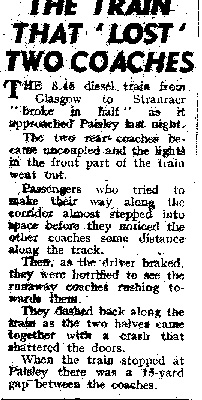
The rear two coaches split from the 8:45pm Glasgow - Stranraer service on the 21st January 1961 when approaching Paisley Gilmour Street. The lights in the front section are reported to have went out as the driver braked for the station, and the two loose coaches ran into the front section. Probably with some artistic license the press reported that some passengers who tried to make their way along the train before it stopped almost stepped out into a void before realising the train had split, saw the loose coaches coming toward them and made a precipitous retreat!
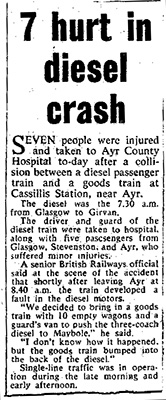
Another alarming incident occurred on the 30th January 1961 when the 7:30am Glasgow - Girvan developed engine trouble south of Ayr and stopped at the closed Cassillis station. A freight worked by Caley 3F 57615 (consisting of 10 empty wagons and a brake van) was called upon to propel the set to Maybole, but unfortunately the loco buffered up to 51038 with such force that the driver and guard of the diesel plus seven passengers were taken to Ayr County Hospital for treatment to minor injuries.
New buffet car 59098 in dark green livery was noted on Saturday 4th February 1961 working the 4.25pm Stranraer Town to Glasgow, and just over a week later on Monday 13th February 1961 the 7.45am to Glasgow included buffet unit 59099, which was also noted in the 5.10pm to Ayr.
AWS was not fitted from new, and on the DMBS some of the equipment was fitted on the top of the bulkhead behind the driver. This involved bolting through from the passenger side, spoiling the formica finish. One of the first noted with this done was 51036 on Tuesday 21st February 1961. 51043 was noted converted on Wednesday 15th March, a day that 79083 was noted sitting outside the old St Enoch engine shed.
Also on the 15th March a serious derailment happened about 2pm at Dalry, when some thirteen wagons on the rear of a freight were spread over the tracks beside Dalry No 3 Box. The Ayrshire coast services were mainly diverted via Kilmarnock, where reversal was necessary. Single line working was still in operation the following morning.
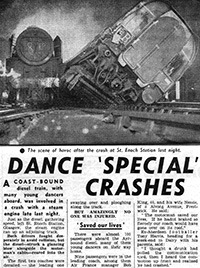
Yet another incident occured just two days later on Friday 17th March, when Clan 72001 'Clan Cameron' came into a sidelong collision at St Enoch with the set working the 11pm to Ayr, consisting of 51022, 59392 and 51032. The following morning (Saturday) vehicles 51022 and 59392 were lying outside the old St Enoch engine shed along with 72001. By Monday the Clan had gone but the DMU cars remained there until Thursday 23rd March with 51022 being belatedly given a tarpaulin covering over the front end by the 22nd.
The same month, to overcome a shortage of 126s, no doubt due to these recent problems, two 107s were loaned to Ayr.
Buffets
When the Ayrshire vehicles were ordered running to Stranraer was not a consideration. When these services were added it was decided the route required buffet cars, as it would take some time to build the additional vehicles in the short term vehicles were loaned from Leith. Ayr required three buffet cars for the Stranraer services - two in traffic and one spare. It received the two ex-WR vehicles (79440/1), and 79443 also put in an appearance for a short time. The delivery of the last two Class 126 vehicles 59098/9 in January/February 1961 gave both Ayr and Leith the spare vehicles that they required. These two buffets were the first Inter-Cities in Loco Green, clashing with the rest of the vehicles which were still in the lighter DMU green.
Ayr did not maintain a spare buffet for long and if one was unavailable a spare trailer was inserted. The buffet facilities were withdrawn on the line (from the 17:10SX, 17:15SO, 20:45SO and 21:00SX Glasgow to Stranraer services, and the 16:40 and 21:15 daily services from Stranraer to Glasgow) from the summer 1961 timetable (beginning June 12th), due to lack of patronage. After buffet services were withdrawn 59098/9 were used as spare trailers with the buffet locked and after about a year migrated to Leith.
Former passengers have stated that on the ‘Irishman’, the buffets were not always manned. A very limited food service was offered, and the train was often well into its journey to Ayr before it opened and the service was not promoted. It was not like the E&G service where an attempt was made to sell the service. Basically, if manned the Steward just sat there and put in his time. Other passengers have claimed that the buffets were normally busy, but the staff that manned then were onto a good fiddle.

The image shows two three-car Swindon Inter-City sets at Prestwick in August 1961. Bill Hamilton.
The X2s
As well as the 79xxx buffets Ayr had received some of the Western Region intermediate cars. They always worked in pairs or as a three car, sometimes coupled to 5xxxx sets but they were never formed into mixed sets. The 79xxx intermediates were called ‘X2’s by the staff, derived from the original classification before ‘DMBS’ was introduced.
One enthusiast became quite friendly with one of the drivers. Late one winter evening he was seated in the 9.55pm St Enoch to Ayr when the driver Jimmy spotted him as he walked up to the cab, and asked if he fancied 'coming up the front' - "Just wait till we’re oot the station and I’ll leave the door unlocked. There’ll be nae inspectors at this time o’night and we’re a’ right wi’ the gaird".
"This train went via the North Johnston line and Kilbirnie. It was fascinating to be in the cab at night as this view was not normally available as the curtains were always drawn to avoid reflections in the windscreen from the passenger saloon. I had noticed on my travels that there were differing levels of expertise among drivers in the smoothness of their stopping and starting. Jimmy was first-class. "Dae ye’ ken how to stop these without a rug’? Watch me at the next stop." So I duly watched and learned how to stop an Inter-City "without a rug". The journey was over all too soon and unfortunately our paths never crossed again at the right time."
"Jimmy didn’t like the X2s in his trains. "They’re trouble". On the other hand, the public loved them and many sought them out to travel in. Their heaters were positively Saharan in effect. There didn’t appear to be any intermediate setting on them. It was full on or nothing. If nothing, you bailed out!"
Another enthusiast travelled on the morning eight-car formation with the X2s (two 5xxxx 3-cars and a 79xxx 2-car) and the following may back up Jimmy’s observations that X2s plus Ayr units were “trouble”. All went well from Ayr right as far as Paisley and beyond but just to the Ayr side of Cumberland Street the ensemble came to a halt. Despite various efforts it became obvious this lot was not going to function as six power cars in multiple. He was unaware of what was done but was very aware of the result. The X2s roaring and spewing out white exhaust, slowly pulled away and dragged the six-cars behind them through Cumberland Street station, over the bridge and into St Enoch!
The Corkerhill night shift fitters used to go over to Bellahouston Stabling Sidings around 2am to prepare the Swindons for the next day: start all the engines and heaters and check the defect books before examining the first class compartments (which generally took the rest of the night) till travelling to St. Enoch on the first ECS of the day. The carriage cleaners did likewise. One night a final drive on one of the units was needing some attention, so the fitter removed the floor hatch, prodded and poked around before going underneath. Unfortunately, he failed to cover the hatch and one of the cleaners fell through it, breaking her leg. Little more was heard of the incident, except a memo to all fitters to keep the hatches covered at all times.

On Tuesday 20th June 1961 a set was routed into the wrong siding at Kyle Street sidings, Ayr. The siding contained four tank wagons, and 51047 hit them with enough force to make one of the tank wagons ride up onto the buffers. Surprisingly other than a flattered cab the DMBS wasn’t too badly damaged and would be repaired. The damaged cab is seen in the image just after being pulled apart from the tank wagons by 2-6-4T No 42196.
On Sunday 25th June 1961 British Railways ran a 6-car Inter City set Land Cruise from Ayrshire stations to Dunfermline and Edinburgh. 2 hours were allowed at both places. Because of delays due to wrong line working at two locations (including over the Forth Bridge) the train was an hour late at Dunfermline but the two-hour time at each was maintained. Departure from Edinburgh was 70 minutes behind schedule.
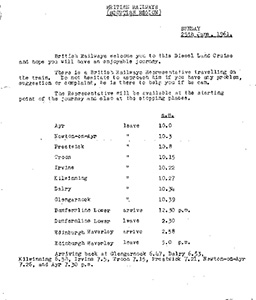
Derailments were probably frequent but because they were quickly sorted not many were recorded. One example was on 2nd December 1961 when 51047 and 59391 were derailed at the entrance to the Kyle Street sidings at Ayr Station.
1962
Some notes from Monday 5th March 1962 – the 6.50 am from Ayr to Glasgow was 10 minutes leaving Ayr and made an unscheduled stop outside Ayr shed before arriving at Newton-on-Ayr. The first three-car set (of the 6-car formation) was isolated with no motors running, no air pressure and no heating. 79086 was the leading car and acceleration was extremely slow. The train was put on the slow line at Paisley and was overtaken by the following ex-Largs train. Arrival at St Enoch was 39 minutes behind schedule. Later in the day 51047, working as the leading vehicle on 3.30pm St Enoch to Ayr had been fitted with a front window roller blind in place of the previous sun visor. The visors were relatively small compared with size of the windscreen and had probably required constant adjustment. The visors were retained in the intermediate power cars with their smaller windows.
On Saturday 10th March 1962 – 51043 was noted with a newly painted buffer beam and the coupling painted blue. The 6.50 am Ayr to Glasgow on Wednesday 9th May 1962 had the leading car - 51038 - isolated with no air pressure.
More colour was added to the front of the class starting in June 1962, with 51042 noted ex-works on Friday 8th June 1962 with a yellow panel at front.
Another derailment at the entry to Kyle Street Sidings at 4am on Tuesday 1st May 1962 resulted in the 6.50am Ayr to Glasgow being reduced to a three coach set instead of the usual six, and at least one Ayr - Glasgow service reverted to steam train that morning.

In the image a six-car formation departs from Stranraer Harbour with the 1.30pm Stranraer Harbour - Glasgow St. Enoch service on July 12, 1962. Many of the passengers will have disembarked from the ferry seen in the background on the left. Michael Mensing.
On Wednesday 25th July 1962 the 5.15pm to Ayr from St Enoch was delayed due to the gears not engaging. It finally left at 5.37pm and was 20 minutes late at Ayr. On Saturday 25th August 1962 the 8.45pm to Ayr left St Enoch 11 minutes late due to lack of air pressure.
Saturday 15th September 1962 – 59408 noted ex-works arriving at Falkland in a southbound class H freight hauled by 45194. After that cars started appearing ex-works in the darker Loco Green, such as 59392 noted on Saturday 16th October 1962.

The image shows a down service at Crookston sometime in 1962, the power car having yellow panels added. Corriebob.
The 7.15am to Kilwinning broke down at Newton-on-Ayr on Thursday 13th November 1962 due to failure of the final drive. It left Newton-on-Ayr at 7.47am and the following 7.45am to Glasgow was delayed all the way to Irvine, where it was held outside the station. The Kilwinning train was turned there and the Glasgow set called at Kilwinning to set down, it made it to St Enoch just 10mins late.
1963
Snow
With the southern end of the Glasgow - Stranraer line passing through some remote areas, winter weather conditions could often have a serious effect on the services. On the 5th February 1963 the 5:10pm Glasgow - Stranraer became stuck in drifts at Barrhill. Some of the passengers were rescued by helicopter the following day, and the remainder taken back to Girvan by a special train which had set out with a rescue party. The next few days were spent clearing the line. On the 8th, to enable passengers to get to Stranraer and on to Ireland, a steam-hauled special was run from Ayr connecting with the 9pm ‘Irishman’ from Glasgow, running via Mauchline and Dumfries. The line re-opened on the 10th, the first train through being a steam-hauled ‘Paddy’. This was short-lived though, as another snowstorm on the 13th/14th blocked the line again. On the 14th and 15th special trains again ran from Ayr to Stranraer via Dumfries, departing Ayr at 11:15pm. On the 14th this was operated by a 3-car Class 126, the following night it was steam hauled. The line was re-opened to steam traffic at the beginning of the following week.
To add to the confusion, the Ayr/Girvan line was blocked for 24 hours due to a derailment at Ayr station. On the evening of the 14th February 1963 a laden coal train with 33 wagons from Waterside ‘ran away’ on the downhill stretch of the Dalmellington branch to the main line at Dalrymple Jct. The crew saw the signals at danger, and expecting to be derailed at the catch points, jumped off. However the line had been set for the train and it continued, crewless, on the main line downhill into Ayr station. At Ayr No.2 signal box 26 of the wagons became derailed and ripped up the track, but the loco with one wagon continued on its path until it collided tender first with a 3-car Swindon unit underneath a road bridge at Ayr station. Fortunately the DMU was empty, but the driver and guard were both injured. Later that evening cranes were brought in from Polmadie and Hurlford, but the clean up proved difficult, as the Black five, 45481 and DMBS 51042 were locked together underneath the road bridge. The other vehicles in the set were 59411 and 51009. Passengers to and from Girvan were conveyed to Ayr by bus. The line was finally cleared at 6.30pm the following day.
Ayr – Stranraer Closure?
In the Beeching Report of 1963, the line between Ayr and Stranraer was put forward for closure, along with the Dumfries – Stranraer line. The Stranraer – Larne steamer service was to continue, it was quoted that only 40% of it’s passengers travelled to Stranraer by train. The latter line did close, with some traffic re-routed onto the former helping it’s case for survival. There had also been suggestions about these two routes closing in 1961, and there was Glasgow – Ayr service cutbacks from December 4th 1961 in an bid to prune non-profitable services. At the time it was claimed that between 1600 and 2000 of the region’s 2750 daily services did not completely pay their way.

In the first image the 7.0pm St. Enoch to Ayr is seen at Hillington West during May 1963. The distants are for Cardonald box, and a steam train is behind on the down slow. Corriebob.

The second image shows a St Enoch bound set entering Corkerhill station in August 1963. Note the white circle coupling code is edged in black to make it stand out on the yellow warning panel. Corriebob.
Timetable Improvement
In the Winter 1963 timetable the 2½ hour 11:25am Glasgow – Stranraer Harbour service was accelerated, calling only at Ayr, Maybole and Girvan. The corresponding 2hr 40mins 1:30pm from Stranraer Harbour to Glasgow services were retained in connection with a midday Stranraer-Larne steamer service which now operated throughout the year.
Problems
On Wednesday 4th December 1963 the 7.45am is recorded as having failed at Ayr. It appeared as a six- car set instead of the usual nine-car formation and ran 13 minutes late.
The following day, Thursday 5th December 1963, the 7.45am to Glasgow failed to get into gear on leaving Prestwick. The driver stopped at the colour light signal at Monkton to try and fix the problem. After 37 minutes it set off again for Troon, with the driver somewhere in an intermediate driving coach. It was held up at Troon Junction before being allowed into the station, during which the 8.00am Ayr to Glasgow train was diverted via the Troon Goods loop (the old direct line) to overtake. During the 15 minute stop at Troon three fitters from Ayr depot arrived and proceeded to lift the floor hatches to try and fix the problem, not the best thing for passenger comfort at that time of year! The train eventually proceeded, after a difficult start, with the fitters still on the train and the driver back in his usual position. A slow start was experienced again at Irvine and an unscheduled stop at Kilwinning (red signal). Train Control had obviously given up the train by this time, as at Dalry it was on to the slow line, and then via the North Johnstone line including the slow line from Cart Junction to Elderslie No 1. There was a 9-minute delay at Paisley Gilmour Street due to failure to start. By this time the engine lights were only showing for the first coach. At Arkleston Junction it was not surprisingly on to the slow line, including a stop at Hillington West to set down. When it eventually got to Shields Junction the only two working engines were pouring out clouds of white vapour. The fumes were drawn into the leading coach through the heating vents and everyone was forced to evacuate to further back in the train. Arrival at St Enoch platform 5 was at 10.29am, one hour and forty-two minutes late. The leading coach was not noted but the second motor coach was 79083. The full set was hauled back to Ayr by a diesel loco. Three Inter City coaches were noted on the coaling-plant avoiding line at Ayr sheds that evening.
The following day the 7.45am to Glasgow train was formed of a Derby 6-car set, which was noted again on the 5.10pm to Ayr.
1964

Sc51043 is seen in the image at the front of the 4.22pm St Enoch - East Kilbride service seen leaving Hairmyres on 20th March 1964. At this time the East Kilbride service had been transferred to St Enoch from Central, but would return to Central when St Enoch closed in 1966. Hamish Stevenson.
A Land Cruise using Inter City units was run on Sunday 9th August 1964 to Southport. It was a 6-car set and called at Newton-on-Ayr, Prestwick, Troon, Kilmarnock, Dumfries and Annan. There was crew change at Carlisle Citadel and a pilot came on at Preston. Arrival at Southport was 5 minutes early at 1.12pm. It was a hazy but sunny day and as the tide was out the passengers never saw the sea!
At the start of the Winter 1964 timetable about 50% of the Glasgow Central – Gourock and Wemyss Bay services were operated by diesel locos or diesel units, varying from day to day in type and formation, from Met-Camm twins to Inter-City sets.
The 'Locomotive Running Past and Present' article in the December 1964 issue of Modern Railway described the performance of a three-car set on a journey from Ayr to Stranraer, working the 17:10 from St Enoch which had been a six car as far as Ayr. The steep gradients the train had to tackle are described along with the gear changes, and despite regularly having to drop to third gear and even when the speed fell to 22 mph and down to second gear the DMU was noted as performing well and arrived at Stranraer one minute ahead of schedule.[3]
1965

Girvan via Kilmarnock?
The Scottish Region was investigating a new hourly diesel service from Glasgow - Barrhead - Kilmarnock (reversal) - Ayr - Girvan, which it would implement if the Minister of Transport refused consent to the withdrawal of Glasgow – Barrhead- Kilmarnock services. The existing Glasgow - Paisley - Ayr service would still continue, but would no longer continue to Girvan.[4] These plans were not progressed.
The image shows a set at Newton-on-Ayr station, date unknown, Steve Davies Collection.
1966
St Enoch closure
Glasgow St. Enoch station closed in 1966, with the last services running on June 26th. The route for Ayrshires departures from St. Enoch was via Paisley Canal station. During the electrification of the Wemyss Bay and Gourock lines, St Enoch was opened up on Sundays from April 24th 1966 to June 19th, and trains ran as per normal via Paisley Canal.

On Sunday 26th June, they ran from St Enoch via Paisley Gilmour Street. The image shows a Swindon Inter-City DMU (and a Derby set) on this day, which would be the last day of operations from the station. Corriebob.
The next day a new connecting line at Shields Junction allowed the Canal line to be reached from Glasgow Central. From then on services used Glasgow Central.
Central station was already one of the busiest on the UK and by far the busiest in Scotland. It would now handle 896 trains through the day - 385 EMUs, 461 DMUs and 50 loco-hauled, with 83,000 passengers daily. More than 100 of these trains were rostered to carry 22,500 travellers to and from the Ayrshire Coast alone.
The Irishman
Unofficially the evening train from Glasgow to connect with the next morning’s sailings from Stranraer to Larne and the corresponding return service was named “The Irishman” right back to G&SW days, but it first appeared as such in the LMS timetable of 1933 when there was a general speed-up of services by this route. The name remained in the timetables until the one covering April 1966 to March 1967, after which it was dropped. Locally the overnight service from Euston to Stranraer was known as the “London Paddy” and the Glasgow service as the “Glasga’ Paddy”.
A journey on “The Irishman” in 1966
Mr James G. Tawes travelled extensively over the national network keeping detailed journals of the timings of each train. In his records was one journey on “The Irishman”, the 9pm from Glasgow Central to Stranraer, on the 26th July 1966. He notes: “Train shown in public timetable as running from St. Enoch, & via Paisley Canal. Altered by supplement of June 27th, on account St. Enoch station and the Paisley Canal route closed.” The weather was noted as dull with drizzle, and the passenger loading as very light. It was a 9-car set leaving Glasgow, which split at Ayr, only three going the full distance, this portion was noted as being lightly loaded.
The formation was (in order):
51031 / 59407 / 51018 + 51021 / 59403 / 51050 + 51037 / 59398 / 51017
(DMBS / TCK / DMS + DMS / TCK / DMBS + DMBS / TFK / DMS)
with the first three going to Stranraer. The noted timings were:
| Booked | Actual | Late | Lost | Gained | Notes | |
|---|---|---|---|---|---|---|
| GLASGOW CENTRAL | 9 0 | 9 0 | - | |||
| Queen Street | 9 3½ | v | ||||
| Arkleston Junction | 9 10 | x | ||||
| PAISLEY (GILMOUR ST) | 9 12 / 9 13 | 9 10½ / 9 12 | - | ½a | ||
| Elderslie | 9 16 | 9 15½ | - | ½b | ||
| JOHNSTONE | 9 18½ | 9 17½ | - | ½b | ||
| Lochside | 9 24½ | 9 24 | - | ½b | ||
| GLENGARNOCK | 9 29 | 9 28½ | - | |||
| DALRY | 9 33½ | 9 33 | - | |||
| KILWINNING | 9 39 | 9 39½ | ½ | ½a & ½b | x | |
| IRVINE | 9 44½ | 9 45 | ½ | |||
| BARASSIE | 9 50½ | 9 50 | - | 1b | ||
| TROON | 9 53½ | 9 53½ | ½ | 1b | ||
| PRESTWICK | 9 59 | 9 59 | - | ½b | ||
| AYR | 10 4½ / 10 10 | 10 4½ / 10 12½ | 2½ | 2½a | y | |
| MAYBOLE | 10 23 / 10 24 | 10 24½ / 10 25½ | 1½ | 1b | ||
| GIRVAN | 10 40 / 10X41 | 10 40 / 10X54 | 13 | z |

Notes
a at station
b by ‘engine’
v not seen (unaware of booking points ) (Sheilds Jn 9 3)
w not seen (unaware of booking points) (p.w.r. Ibrox)
x cause of delay not observed
y Parcels Traffic
z crossing 9 20 Stranraer—Glasgow “The Irishman” due 10 24, arr 10 51 1/2
The image shows a Swindon set in amongst the diesel and steam locos in the West end of Corkerhill Shed in July 1966. corriebob.
Slowdown of Journey Times
Modern Railways magazine did a comparison between the 1966 timings of the Glasgow - Ayr - Stranraer service and those in 1939. The 1966 11:25 Stranraer boat train took 48 minutes for the 41.4 miles from Glasgow to Ayr, with one stop at Paisley Gilmour Street, comparable with the 45 minute non-stop schedule of the 1939 17:10 from St Enoch. That non-stop service was supplemented by 16:10 and 17:40 stopping services scheduled for 59mins, the 1966 Ayr commuters returning from Glasgow had no non-stop service and slower stopping trains; the 16:30 taking 65 minutes, the 17:06 taking 61min, the 17:15 in 65min, the 17:42 in 63 min, and the 18:30 in 61min, although all did have additional intermediate stops. Another disappointment between the 1939 and 1966 boat trains - the former had a restaurant service.[5]
1967

Overcrowding
A shortage of serviceable vehicles at the start of 1967 saw DMU services to the north & south of the Clyde running in shorter formations, leading to many public complaints, in particular on the Glasgow – Ayr services.
In the image a Swindon DMU set unloads its passengers in Corkerhill station on April 2nd, 1967. Hamish Stevenson.
On Saturday 9th September 1967 the 5.07pm train from Glasgow to Ayr caught fire en-route and was towed to Glengarnock by D7617 and the train shunted out of the way. The following 5.25pm to Ayr was held at Beith North and then stopped at Glengarnock to pick up the passengers off the 5.07.
1968
Hugh Docherty recounts further exploits with the Class: "Once St. Enoch was closed the Swindons became part of the scenery at Central Station, heading south and west from platforms 12 and 13. By 1968, as a student, I had the chance to take the Swindons where I had always wanted to go by train — right past Troon, to Stranraer itself.
This was the Swindons at their best, roaring up the Doune Bank at 1-in-54 from Girvan, on a Stranraer boat train. If it was fascinating to sit in the rear cab and watch the speedo and rev counter dials on the flat, it was something else to watch them over the banks around Pinwherry and Barrhill. Driving a Swindon over that road called for the skills of an artist; with a combination of power-on, power-off, a rub of the brake, and knowing just when to change up or down; all signs of old steam skills transferred to the new diesels.
Then there was the sheer remoteness of a Swindon on the Chirmorie, scenes such as drinking water being passed out at Barrhill, and the ever-fascinating token exchanges at the passing loops on the line. The drill for a Swindon driver was to charge through the loop, as at Glenwhilly, drop the cab window, kneel up on the control desk, knee on the throttle deadman’s, and do the exchange, power fully on, hand-over-hand, with the signalman, who must have had nerves of steel. Once hauled in, the token (in its hoop) would be hung over the vacuum brake and the driver would pile on more power, confounding today’s health and safety officers who would have been dumbstruck at the whole ritual."
1969
A three-car set worked the Stephenson Locomotive Society 'Tam O'Shanter' railtour starting from a rainy Ayr station on 10 May 1969 (intinerary on Six Bells Junction). Unusually the formation contained two DMBS vehicles (one from set 157 the other from 163 - the latter being 51042) — possibly specially for the tour to give two full width cabs.

This image shows a mixed-livery set heading for Largs in June 1969. It is about to pass Dalgarven signal box, closed and in the course of demolition. Corriebob.
One final word about the 1960s from George Dawson: "Memories of the 21:15 from Stranraer Harbour running non-stop from Ayr coming down the bank past Howwood with the speedometer needle hitting the stop at well over 80 mph and jolting round the S-bend at Milliken Park (it seemed much more pronounced back then) — alarming!"
1970

The image shows a set with DMS SC50936 closest awaiting departure from Glasgow Central on 12th August 1970. David Mant.
Glasgow Central Collision
On 19 October 1970 a 3-car working the 12 noon to Ayr departed from Glasgow Central 10 minutes late because of engine trouble. At the same time a 3-car EMU left bound for Gourock, and soon after leaving the station, and 20 yards from the signal box (at the time one of the most sophisticated in Europe) the two sets were involved in a converging collision.
Two passengers on the Gourock train were taken to hospital and treated for minor leg injuries but not detained. There was considerable disruption of services until the lines were cleared and normal services resumed the following morning. The EMU driver was held responsible for his train being driven past two signals at danger.
1971

In 1971 a DMS derailed of a set traversing the entrance to Kyle Street sidings. As well as the inconvenience of re-railing, all the sets stabled in the siding were blocked in.
The image shows Class 126 DMU winds its way into the correct platform in Glasgow Central in 1971. One vehicle is in blue / grey, probably a 79xxx vehicle. John Law.
1972

On July 15th 1972 traffic between Ayr and Glasgow was delayed by a fire scare and trains arriving in Glasgow were up to three hours late, including one train which arrived after midnight. A fleet of buses were rounded up to take passengers to their destinations.
The image shows a 6-car formation between Troon and Barassie, the train heading towards Glasgow. Date unknown. Stuart Rankin.
1973
Bellahouston Collision
On the 30th August 1973 EMU unit 091 operating 1N40, the 9:35pm Wemyss Bay – Glasgow Central service, crashed into the rear of 1A74 the 9:10pm Ayr – Central DMU at Kinning Park / Ibrox near Shields Junction. That day there had been problems with the train describer between Paisley and Glasgow Central signal boxes, and the Glasgow box was stopping trains as they approached Shields Junction to identify them so that they could be correctly platformed at Central. The 126 had just been restarted from this stop, and reached about 15mph before being struck in the rear by the EMU travelling at about 65mph. The rear coach (51011) of the 6-car Class 126 was telescoped on top of the front coach of the EMU, touching the overhead wires causing traction power to be cut off. The force of the collision drove the trains, locked together, forward 225 yards. Before they stopped a severe fire broke out, fed by leaking fuel from the ruptured DMU tanks, totally engulfing the two vehicles. The EMU driver and four other passengers were killed, and 51 others sustained minor injuries.

The image shows Sc51011 being lifted from the EMU, probably the next morning.
The enquiry found that although the EMU driver had consumed some alcohol before leaving Wemyss Bay, and the post mortem showed a significant blood alchohol level, other tests showed contradictory evidence that this was the cause. There were indications that he had some sort of coronary incident a short time before the accident, and it was concluded that an attack of anginal pain caused the driver to react incorrectly to AWS warnings.
The leading EMU car, 75857, was repaired, but 51011 was withdrawn. Sc59406 and 51033 were also damaged but repaired, the leading set (51023 + 59398 + 51017) suffered little or no damage. At this time, there were still lots of E&G vehicles around, yet to be disposed off, mainly at Millerhill Yard. The following weekend Railway officials visited Millerhill to examine the possibility of reforming the damaged DMU with some of these stored vehicles. Apparently 79108 was allocated as a replacement, until was realised that an 79xxx leading vehicle was not suitable (possibly due to the lack of cab end jumper sockets), and 79165 was the next substitute. It was noted working an Ayrshire train, it’s blue/grey livery contrasting with the all blue of the other vehicles. There must have been problems with this car, as 79168 was the eventual replacement - probably picked as it was the next one in the scrap line.

Image: With the token exchanged, the signalman heads back to the signalbox as the 10.42am Glasgow Central - Stranraer Harbour continues through the closed Glenwhilly station on the 10th August 1973. Michael Mensing.
Hugh Dougherty continues his reminiscing: "The Swindons gave superb views of the stunning scenery of the Stranraer line and, even by the mid-’70s, the Irish boat traffic could mean standing room only on busy summer Saturdays, when many a Swindon would slog up from New Luce, up the Swan’s Neck, in second gear, the driver praying that he wouldn’t have to go down to first to get there.
By 1973, I was going out with my wife-to-be, and our summer Saturday ritual would be to head for Troon, on a Swindon of course, and, even then, sitting at the front, the ageing units could still knock up 70 down the straight past Castle Semple Loch, although, by that time, slackness in the axle bearings produced a rather alarming side-to-side rocking motion, cured by a rub of the vacuum brake.
But these were the days when the trains were beginning to be declared “a failure” by railway staff. They were getting on a bit, and the sight of late Ayrshire commuters rushing off the platforms at Central was a familiar one as the ‘70s wore on, with the equally common sight of fitters, black from head to toe, lying under the trains, almost as soon as they stopped at Central, and getting engines running again by uncouth but effective methods such as hitting them with sledge hammers. My wife had a friend who lived in Girvan at that time, and her comments on the Swindons were unprintable — as were those of a colleague who travelled daily to and from Troon. Basically, BR had had its money’s worth and more. And the end was nigh."
1974
National Traction Plan

The 1974 National Traction Plan - which reviewed the life expectancy of all stock - gave the vehicles an ‘A1’ code, the highest possible, indicating retention till after 1981.
The image shows a Class 126 heading out of Barrassie with a Stranraer train on 26 June 1974. Tim Stubbs.
1976
On 20 August 1976 the trailing bogie of 51020 leading the 2A63 6:35pm Glasgow Central – Ayr was derailed as the train passed Hillington East. A defective axle had caused a wheel to collapse but no injuries were recorded. This vehicle was reported to have emerged from Glasgow Works only six days earlier.[6]

Sc51015 failed at Stranraer with flat batteries on 8 September 1976 and 25 025 was attached to haul the set on the service to Ayr, where it is pictured. Another set is on the left. Arnie Furniss.
In the mid-1970s Ayrshire - Scotland’s equivalent of London’s stockbroker belt - had one of the highest rates of car ownership per family, yet the 50 min Ayr-Glasgow DMU service retained very healthy business. By bus the journey took 80 mins.
1977
The 4:35pm Glasgow Central – Girvan was delayed at Lochside on the 5th April 1977 when 51028 caught fire, necessitating the attendance of the local fire brigade.

In the image two sets pass in Kilwinning station during April 1977, one bound for Glasgow Central, the other Ayr. Alan Rintoul.
The Ayrshire services in 1977 could be summarised as a train in each direction every half hour. The Ayr trains called only at Johnstone, Kilwinning, Irvine and Troon. Alternate trains served Dalry, Barrasie and Newton. The only exception was the 10:42 am boat train, which called only at Paisley, Kilwinning and Johnstone. It was now the only passenger train to use the direct line from Barassie. Normally, trains were 6-car formations increased to nine in peak hours, and sometimes reduced to three during afternoons. Average journey time was about 65 mins. At the end of steam there was a non-stop working in the morning and evening, which did the journey in 50 mins. The nearest in 1977 was the 10:42, allowed 54 mins with three stops. This was one of five though trains from Glasgow to Stranraer, with an extra on Saturdays, all of which connected with a sailing to Larne, and the same in the reverse direction. Strangely, although all were shown at Glasgow Central as connecting, only the 10:42 was officially known as the ‘boat train’ and given a slightly faster timing. Additionally there were six trains each way from Glasgow to Girvan. North of Ayr, all these Girvan trains slotted into the half hourly sequence.
1978

The image shows DMBSL SC51031 from Set 401 stabled on Ayr MPD on the 2nd May 1978. Other than the rail blue livery the vehicle is as it was delivered to BR in May 1959. Bob Woolnough.
In the summer of 1978 some refurbished 101s were appearing on Glasgow - Ayr/Largs workings.
One of Ayr's 79xxx vehicles, DMS 79168, would be withdrawn in September, the vehicle was taken off its bogies and would sit as a grounded body in Ayr depot until at least August 1981.
On 24 October 1978 the 8:08am Glasgow Central – East Kilbride was formed of a 6-car Class 126. This was the first reported Inter-City set on this branch since September 1971 when an E&G 5-car set (formed after Push-Pulls commenced in May 1971) ceased working a mid-day fill-in turn.
Joe Turner described a journey made by a friend travelling from Glasgow Central to Ayr some time in the late 1970s or early 1980s. The train was made up of a Class 126 unit, but had an ex-Western Region Mk. 1 FO on the back. Also, the first one or two cars were locked out of use but were opened up later in the journey. The FO was open for public use throughout the journey.
1979
Paisley Gilmour accident
At 7:50pm on the 16 April 1979, the 7:40pm six-car EMU from Glasgow Central – Wemyss Bay was crossing from the down fast line to the down Gourock line at Wallneuk Junction, at the east end of Paisley Gilmour Street station, under clear signals when it was struck, head on, by the 6:58pm Ayr – Glasgow 6-car Class 126. The DMU had just departed from platform 2 on the down Ayrshire line and had passed it’s signal (protecting the junction) at danger.
The leading vehicles of both trains were extensively damaged, the DMU riding over the front coach of the EMU. Five passengers and both drivers were killed, and 68 required hospital treatment The investigation found that the DMU driver, having received the “train ready to start” bell from the guard, did not heed (as was his duty alone) the signal clearly displaying a red aspect ahead of him. This resulted in the BR rule being changed from the 2/2/80 so that, as far as practicable, the “Right Away” signal is only given by guard or station staff when the starting signal has been cleared.
The vehicles involved were:
51031 / 59412 / 51014 + 51044 / 59398 / 51017
75840 / 61850 / 75784 + 75802 / 61812 / 75746

Carlisle
In late 1979 the 9:10am Ayr – Carlisle and 2pm return was usually a Class 107 but a occasionally a 126 worked the diagram. Know workings included the 6th August, 1st, 15th & 27th October and 13th, 14th & 15th November, and further workings in December, and these continued into 1980.
The image shows set 411 (DMBS Sc51041, TS Sc59393, DMS Sc51026) at Carlisle on the 6th August 1979 with GG (Greater Glasgow) Trans-Clyde branding. Robert Frise.
1980
A shortage of DMUs in Scotland at the start of 1980 resulted in loco-hauled substitutions, such as on the 7th January when 47 459 and eight Mark l coaches worked the 5:12pm Glasgow to Ayr DMU turn.

The image shows Class 126 and Class 101 vehicles inside the unusual location of Dunfermline Townhill depot in May 1980. The reason for them being there is unknown, the depot was possibly assisting with a backlog of maintenance / repairs on the ageing fleet. Alan Rintoul.
In the summer of 1980 refurbished 101s were putting in regular appearances on Glasgow – Largs / Ayr workings.
On the 15th September 1980 25072 was noted hauling a Glasgow bound DMU through Dunragit (six miles out of Stranraer), which had become inoperable at Stranraer prior to departure.
Trouble with the Class 47 loco working the 11:00am Stranraer – Euston on the 20 October 1980 at Dunragit saw the passengers transferred to the 3-car 126, leaving about an hour late.
About two weeks later, on the 3/11/80, it was the turn of the 126 to fail, and the 7:20am Stranraer – Glasgow DMU was noted passing Dunragit 20 minutes late hauled by 25 049.
More drama four days later again at Dunragit, when the 9:25pm Stranraer – Glasgow halted at it’s normal passing time, but following a conference between the driver and signalman, the train returned to Stranraer, to collect more passengers! It passed through Dunragit once more 29 minutes late.
1981
At the start of 1981, Ayr still was operating the Class 126 fleet on all its main passenger duties, although it also had a small number of other units available. Largs services were operated by Hamilton based units and it was now very rare to see Swindons on this route. Corkerhill depot was being modernised, and the Edinburgh - Dundee DMU services were being switched to locomotive haulage. The surplus DMUs from Haymarket were transferred to Ayr in order that the fast deteriorating 126s could be withdrawn. It took 15 months from the time of the first mass withdrawal till the last one went, mainly because of difficulties with the incoming 101/107/116 vehicles.
A shortfall of funds for track renewals on the ScR in 1981 saw a number of speed restrictions imposed on lightly-used lower-speed lines, including the route from Ayr to Stranraer.
On the 9th May 1981 the 9:25pm from Stranraer to Glasgow hit two cows about one mile from Dunragit. Passengers had to be transferred to a much delayed following train.

The image shows 126 414 led by Sc51044 leaving Ayr for Girvan in 1981. 126 414 was noted as one of the best condition Class 126 sets at the time. Andrew McConnell.
The beginning of the end
In May / early June some vehicles were placed in store, and in July 1981 the first batch of vehicles were withdrawn - the two remaining 79xxx vehicles 79088/470 and one set worth of the later vehicles (51019/45 and 59405).
One day in August 1981 the incoming 6-car 3:05pm Ayr - Glasgow was used as the 6:00pm Central to Shotts due to the failure of a Derby set. It returned to Hamilton via Motherwell, then ECS to Corkerhill.
On September 5th another set worth of vehicles - 51014/41 and 59399 - were withdrawn. There were larger numbers withdrawn in November.
By the end of 1981 34 cars had been condemned. 51014/24/35/41 and 59396/9 had headed south for disposal in October 1981, and stripped down 51009/10/9/21/3/7/30/45/7/9/50, 59391/5, 59403/5/9, 79088 and 79470 were sent to Thornhill, near Dumfries, for storage in early December 1981. Lying at Falkland Junction, Ayr, were 51022/32/3, 59393/4 and on Ayr depot itself were 50936, 51018/46/51 and 59392.
1982
Another batch of vehicles were withdrawn in February 1982.

The image shows 51017 on the rear of 59397 & 51038 departing Glasgow Central on the 9th April 1982. Jerry Glover.
Units remaining in service 1/4/82:
404 51029 59402 51034
406 51016 59411 51036
407 51015 59407 51037
408 51017 59397 51038
409 51020 59400 51039
410 51008 59408 51040
412 51025 59398 51042
413 51026 59404 51043
414 51012 59412 51044
418 51013 59410 51048
Note: 51013 carried unit no. 126 410
51025 carried unit no. 126 418
51020 written off because of accident damage at Stranraer 10/4/82
The Stranraer service went loco hauled in May 1982. The date for the class withdrawal had originally been May 1982, however the replacement Class 101/107s could not cope with the 570 miles per day Ayr diagrams with the same reliability, and over one spell of a few weeks 40 engines failed with fuel pump problems. While half the class was withdrawn almost together, the rest had to battle on, receiving just minimal attention. Any failure that could not be repaired without major work meant withdrawal.
On Tuesday 1st June 1982 the Pope visited Glasgow and a 3-car and two 6-car Swindons were in operation as relief units. The two 6-car sets spent much of the afternoon in Smithy Lye carriage cleaning depot before returning to Ayr, although the formation comprising 126 412 and 126 410 made at least one more visit to Glasgow that day.

The image shows a class 126 formation and a class 37 at the site of Shields Road Station on 1st June 1982, the rear class 126 vehicle is DMS(L) Sc51008. Andrew McConnell.
The following day two units were operating on the Kilmacolm branch, and while they were known to occasionally work the line, it was the first known occasion that two sets were in operation.
On the 21st June 51044 + 59412 + 51020 was noted on Glasgow - Ayr services, with 51008/12/3/6/7/29/34/6-40-8, 59397 and 59400/7/8/10/1 stored in the yard south of Ayr station. On the 25th June 1982 noted in traffic were 51025 + 59398 + 51042 and 51026 + 59404 + 51043.
By the end of summer any not in service were to be found at Thornhill, Townhill Coal Yard, or down south.
The remaining cars were withdrawn in August 1982, although two sets were re-instated the same month to cover a stock shortage, these being sets 406 (51036 + 59411 + 51017) and 413 (51043 + 59404 + 51026). These were mainly used on fill in turns on the East Kilbride and Kilmacolm branches, although there were times when neither of them would appear for days.
A trainload of boarded up units was noted being towed south over the Settle & Carlisle line on the 9th September 1982. This was likely to contain 51008/12/8/22/32/9/40, 59392-4, 59400/6/8 which were noted at March on the 2nd October.
Ayrshire Wanderer Railtour
This tour was organised as a fundraiser for the group that was set up to preserve a unit – The Swindon Preservation Society. It ran on Saturday the 9th October 1982, leaving Glasgow Central at 09:30. Although a 3-car was requested, the northbound working for the set was the 07:45 ex-Ayr, which was a 6-car set, so they were just left paired together. They were the last two sets in traffic, 126 406/413 (51017 / 59411 / 51036 + 51043 / 59404 / 51026).

After a pickup at Gilmour St. they ran to Holm Junction, Ardrossan South beach, then the harbour branch down to Winton Pier. Next it visited the Hunterston Iron Ore Terminal for another photo stop (seen in the image by Ian MacDonald), then to Largs for a lunch break.
Then it was off via Byrehill Jct and Kilwinning (using the freight line from Dubbs Jct), passing Falkland Junction Yard with a big line of withdrawn 126’s (despite that a month earlier 10 vehicles - and 2 Cravens - moved to A Kings at Snailwell). At Newton Jct the Mauchline line was taken, until Annbank when the Killoch Colliery branch was used. After a look around it was off to Waterside via Mauchline, Kilmarnock, Barrassie, Troon and Ayr where there was a stop for tea. Kilmacolm was reached in darkness, the last stop before returning to Central. Afterwards the two sets returned to their normal diagram operating the 21:00 Glasgow to Ayr, and the 22:15 return to Glasgow.
These last two sets were noted in traffic on the 20th and 22nd October 1982. The rapid withdrawal of the Class was still causing stock shortage problems, and in November five Cravens sets were sent from Norwich to help out. The 126s were also noted in use on the 12th December.
On the 23rd December they deputised for a loco failure, working Ayr – Stranraer – Carlisle – Ayr.
1983 - the final year
On January 5th the two remaining sets were in use on the Kilmacolm line as a six-car set. That branch would close a few days later with the last train running on the 8th. From the 6th January the two sets became regulars on the Girvan service, particularly the 2pm ex-Glasgow.
On the 22nd January 1983 both sets (now formed 51017/59404/51043 + 51026/59411/51036) worked the 9:45am Ayr - Glasgow. That day they then operated services to East Kilbride, during which they suffered some interior vandalism. Thankfully though the damage was light.

Their last reported day in traffic was the 24th January. They had been running well right up to this date. Afterwards, with interest show by a preservation group, they ran from Corkerhill to Dunfermline Townhill depot for safekeeping during the tendering process. Rumours are that while stored there they did a few late night trips around the Fife Circle to keep them in shape! Townhill depot closed in March 1983, but the six vehicles were still noted inside on the 3/4/83.
The image shows Sc51036, Sc59411 and Sc51026 at Dunfermline Townhill in early 1983. Andrew McConnell.
Ayrshire Electrification
Just the day after their last in traffic there was a ceremony at Ayr station on the 25th January 1983 where the British Rail Chairman Sir Peter Parker officially marked the start of work on a £68 million scheme to electrify the Paisley – Ayr/ Ardrossan lines. Electrification of the route had been on the cards since 1968.
Disposal

Stripped of it's engines and with all windows boarded up due to asbestos contamination the image shows DMBS SC51042 lies dumped in Falkland Yard, Ayr on the 21st May 1983. Bob Woolnough.
By the summer of 1983 only a handful of Swindons were left at Falkland Jct 51036/33/???/411, along with some Cravens. On 28/6/83 a Class 26 took eight Swindon vehicle to Snailwell on 6X18, leaving Falkland at 21:00. In September 1983 the remaining Swindons left Ayr for the last time, to Dumfries where they stayed a few weeks before moving South. Seven vehicles were noted at Dumfries on the 1st September, including the unbought set from Dunfermline, being shunted by a Class 25. Vehicles, including 51036, were noted at Whitemoor Yard, March, on the 19th December 1983.
References
- ⋏ a b c p265 August 1960 Railway Observer
- ⋏ Notes from Bill Hamilton supplied to the Swindon Diesel Preservation Society
- ⋏ Modern Railways, p413 December 1964, Ian Allan
- ⋏ Modern Railways, p424 July 1965, Ian Allan
- ⋏ Modern Railways, p198 September 1966, Ian Allan
- ⋏ p346 October 1976 Railway Observer
The Railway Observer is the journal of the Railway Correspondence and Travel Society
Summary
Description
Works Photos
Diagrams & Design Codes
Drivers Instructions
Numbering
Liveries
Operations
Images
Details about the preserved Class 126s can also be found here.



